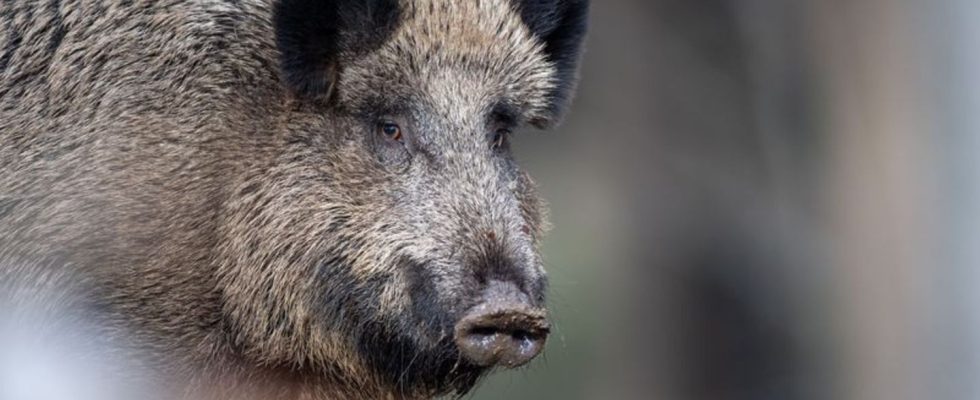study
Wild boars significantly affected by nuclear weapons tests
According to a study, the sometimes high level of radioactive contamination of wild boars, especially in Bavaria, is due to an unexpectedly high degree to nuclear weapons tests. photo
© Lino Mirgeler/dpa
You hear it again and again: Decades after Chernobyl, some wild boars, especially in Bavaria, are still highly radioactive. But is the reason really only the reactor catastrophe of 1986?
The partly high radioactive contamination of According to a study, an unexpectedly high proportion of wild boars, especially in Bavaria, can be traced back to nuclear weapons tests – and thus not only to the Chernobyl reactor catastrophe. The so-called fallout has spread worldwide – and also found precipitation in Bavaria, the scientists explain in the journal “Environmental Science & Technology”.
In some cases, two-thirds of the radioactive cesium in the animals examined came from nuclear weapons tests that were detonated above ground, primarily in the 1950s.
Far exceeded the EU limit
The researchers led by the radioecologist Georg Steinhauser from the Technical University of Vienna examined around 50 wild boar killed in Bavaria from the years 2019 to 2021 and found a contamination with the radioactive isotope cesium-137 of 370 to 15,000 becquerels per kilogram. This exceeded the EU limit for consumption by a factor of up to 25. It is 600 becquerels.
Steinhauser and his team of scientists explain that it had previously been assumed that the Chernobyl reactor accident in 1986 was the main source of cesium-137 in the wild. But now, during a detailed analysis of the isotopes, they found that the cesium-137 produced during nuclear weapons tests contributes significantly to the pollution of the wild boar. It is the first study to quantify the cesium from nuclear weapons tests, Steinhauser told the German Press Agency.
Advice for hunters and mushroom pickers
Cesium-137 is a radioactive isotope that does not occur naturally. According to the German Cancer Research Center (DKFZ), it can accumulate in bone tissue and damage the genetic material there. In the long term, this can lead to bone cancer and leukemia. The Federal Office for Radiation Protection (BfS) writes on its website that hunters and mushroom pickers should find out about their additional radiation dose from the consumption of wild mushrooms and game.
According to Steinhauser, around 10 percent of the radioactive cesium in Bavaria can be traced back to the nuclear weapons tests, around 90 percent to Chernobyl. Still, up to 68 percent of the cesium in the wild boar came from nuclear weapons—an astonishingly high proportion. To determine the origin of the radioactive contamination, the researchers determined the ratio of cesium-135 to cesium-137.
“Even if Chernobyl hadn’t happened, some samples would exceed the limit,” Steinhauser said. “Responsible for this might be the deer truffle, which lives underground.” Because the cesium only migrates slowly through the soil, it arrives late at the fungus. “This explains why the ‘old’ cesium is disproportionately high in the wild boar – the Chernobyl cesium has not yet reached its full extent in the deer truffle.” Especially when the food on the surface becomes scarce towards the end of winter, the animals have to dig and feed on the fungus. This also explains why pigs shot in winter tended to be more contaminated.
The consequences of above-ground nuclear weapons tests
Nuclear weapons were tested above ground mainly in the 1950s to 1963 by the USA and the Soviet Union. This is where the main part of the radioactive load comes from, later tests are of secondary importance, said Steinhauser. However, this also shows how high the burden must have been at the time. Because cesium-137 has a half-life of 30 years. This means that today only 25 percent of this radioactive cesium is left anyway. About 42 percent of Chernobyl should therefore still be available.
The BfS only reported on Monday that many fungi, especially in Bavaria, are still contaminated with radioactive cesium. Areas in the south and east of Bavaria are particularly affected, where the most radioactive cesium was deposited in Germany after the Chernobyl reactor disaster. With certain mushrooms, investigations in the years 2019 to 2021 measured up to 4000 becquerels of cesium-137 per kilogram of fresh mass. However, it was not examined here whether the cesium also came from nuclear weapons tests.

